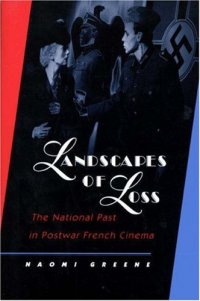
Ebook: Landscapes of loss: the national past in postwar French cinema
Author: Naomi Greene
- Year: 1999
- Publisher: Princeton University Press
- City: Princeton, N.J
- Edition: First Edition
- Language: English
- pdf
The way in which every European country after the WW2 reacted facing the inner and outer demons the bloody traces sealed in upon the collective unconscious, evidently varied from nation in nation. While Italy decided to make a profound revision of its own nature (The Italian Neo-realism) or Germany (supported by a marvelous literary movement and the extraordinary raising of memorable directors such as Fassbinder, Herzog, Wenders, Kluge, Schlondorff or Aldon), France due in great part to their multiple artistic tendencies, didn't' t react as it were, unanimously on the same way. United Kingdom bet for profound dramas (The 49th Parallel, The rocking horse winner, A brief encounter, The fallen idol, The third man, Great expectations, Nicolas Nickelby) and then during the fifties, bet for the comedy, obtaining marvelous results (The lavender hill mob, Kind hearts and cornets, The man in the white suit, The lady-killers or The Hobson's choice) with the raising trajectory of the most important British director David lean.
Marcel Carne, after his extraordinary cinematography before and during the WW2 with unforgettable films such as The night visitors, Port of shadows, Le jour se leve or his masterpiece The children of paradise) knew to maintain the poetic gaze with marked realist accent such Le ports de la nuit or Theresa Raquin (based on Emile Zola's novel).
On the other hand Jean Renoir turned his acidic works into major horizons (The river, Elena and the men, The French Can Can or the Elusive corporal).
But meanwhile a literary movement of a new generation of young promises -led by the legendary Andre Bazin- (Erik Rohmer, Claude Chabrol, Francois Truffaut, Jean Luc Goddard or Robert Bresson) brandished their ideas in a newness magazine named Cahiers de Cinema, that generated the most original movement based on simple themes of the reality, best known as The French New Wave, that produced among them different creative perspectives and nourished at the same time new arguments Robert Bresson was the most independent filmmaker among all of them and demonstrated the astonishing profundity of thinking like nobody else. Something similar it would happen with Rohmer who walked over with incisive and brilliant works and Chabrol that developed to transit by a sort of anguishing cinematography (The butcher or Que la bete meure). Max Ophlus is an apart case, but inside his spirit nestled his major work that would dazzle the world in 1972 The sorrow and the pity. And other four important protagonists are worthy to mention: Rene Clement with a very personal aesthetics (Forbidden games, Purple noon, Is Paris burning?), Jean Pierre Melville an emblematic and versatile master of the direction, who transited through many different ways of expression, Alan Resnais, the most eclectic French filmmaker ever born with an existential proposal (Night and frog, Hiroshima mon amour or The last year in Mariembad) and finally the talented and more attached to the narrative traditionalism Jean Delanoy ( The Pastoral Symphony, Marie Antoinette or the Hunchback of Notre dame).
The marvelous insights behind stages, the French ethos and the unknown details that determined this important movement of filmmakers are expressed with sobriety, passion and eloquence, engaging the most exigent reader thanks its lucid prose.
A text that it must be part of any serious artistic library.
Marcel Carne, after his extraordinary cinematography before and during the WW2 with unforgettable films such as The night visitors, Port of shadows, Le jour se leve or his masterpiece The children of paradise) knew to maintain the poetic gaze with marked realist accent such Le ports de la nuit or Theresa Raquin (based on Emile Zola's novel).
On the other hand Jean Renoir turned his acidic works into major horizons (The river, Elena and the men, The French Can Can or the Elusive corporal).
But meanwhile a literary movement of a new generation of young promises -led by the legendary Andre Bazin- (Erik Rohmer, Claude Chabrol, Francois Truffaut, Jean Luc Goddard or Robert Bresson) brandished their ideas in a newness magazine named Cahiers de Cinema, that generated the most original movement based on simple themes of the reality, best known as The French New Wave, that produced among them different creative perspectives and nourished at the same time new arguments Robert Bresson was the most independent filmmaker among all of them and demonstrated the astonishing profundity of thinking like nobody else. Something similar it would happen with Rohmer who walked over with incisive and brilliant works and Chabrol that developed to transit by a sort of anguishing cinematography (The butcher or Que la bete meure). Max Ophlus is an apart case, but inside his spirit nestled his major work that would dazzle the world in 1972 The sorrow and the pity. And other four important protagonists are worthy to mention: Rene Clement with a very personal aesthetics (Forbidden games, Purple noon, Is Paris burning?), Jean Pierre Melville an emblematic and versatile master of the direction, who transited through many different ways of expression, Alan Resnais, the most eclectic French filmmaker ever born with an existential proposal (Night and frog, Hiroshima mon amour or The last year in Mariembad) and finally the talented and more attached to the narrative traditionalism Jean Delanoy ( The Pastoral Symphony, Marie Antoinette or the Hunchback of Notre dame).
The marvelous insights behind stages, the French ethos and the unknown details that determined this important movement of filmmakers are expressed with sobriety, passion and eloquence, engaging the most exigent reader thanks its lucid prose.
A text that it must be part of any serious artistic library.
Download the book Landscapes of loss: the national past in postwar French cinema for free or read online
Continue reading on any device:

Last viewed books
Related books
{related-news}
Comments (0)